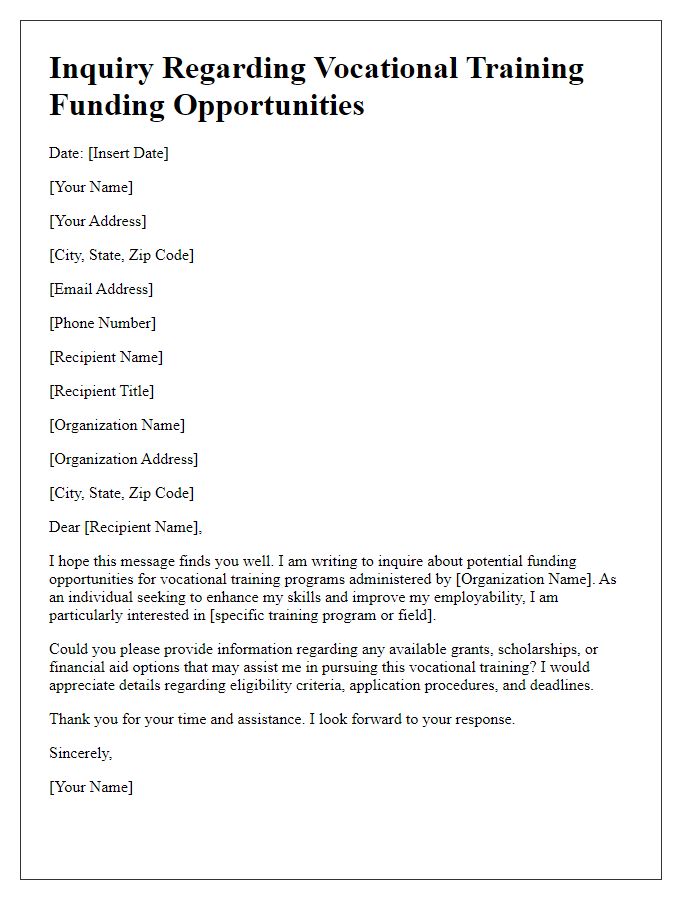Are you looking to take your skills to the next level with a vocational training program? Securing funding for such an opportunity can be a game changer in your career journey. In this article, we'll explore effective strategies and essential tips to help you navigate the funding process smoothly. So, if you're ready to unlock your potential, read on to discover how you can make your training dreams a reality!

Objective and Purpose
Vocational training programs play a crucial role in enhancing workforce skills in various industries, particularly those experiencing labor shortages, such as healthcare, construction, and technology. These programs, often structured to accommodate diverse learning styles and schedules, aim to equip participants with practical and marketable skills, thereby increasing employability. A targeted investment in vocational training can address unemployment rates, promote economic growth, and support local businesses seeking qualified candidates. Moreover, aligning training curricula with industry demands ensures that graduates possess relevant expertise, ultimately benefiting both employers seeking skilled labor and individuals striving for career advancement and stability.
Target Audience and Demographics
Vocational training programs serve diverse target audiences, primarily including unemployed individuals seeking job opportunities, low-income youth aspiring to enhance their skill set, and career changers aiming for new industries, such as technology and healthcare. The demographic composition often includes adults aged 18 to 35 years, with significant participation from marginalized communities, including minorities and individuals with disabilities. Geographic distribution varies widely, with urban areas, such as New York City and Los Angeles, having higher concentrations of participants due to greater access to training facilities and employer partnerships. The need for funding in these programs is crucial as they play a vital role in equipping participants with essential skills, certifications, and hands-on experience necessary to thrive in the evolving job market, thereby contributing to economic growth and personal empowerment.
Budget and Financial Breakdown
Vocational training programs require comprehensive financial planning to ensure sustainability and resource allocation. The total funding required for a vocational training program, such as a plumbing apprenticeship initiative in Washington State, amounts to $150,000. This budget covers various essential components: staff salaries, estimated at $80,000 for experienced trainers and administrative personnel; materials and equipment, totaling $30,000, encompasses tools, safety gear, and classroom supplies; venue rental, costing $10,000, includes costs for a training facility in Seattle; marketing and outreach, projected at $15,000, aims to attract potential students through community workshops and online platforms; and contingency funds of $15,000, reserved for unexpected expenses. Proper financial oversight and allocation ensure the program effectively meets the educational needs of each participant while maximizing resource utilization.
Expected Outcomes and Benefits
The funding for the vocational training program aims to equip participants with essential skills tailored to meet workforce demands across industries. This initiative targets an estimated 500 individuals, primarily unemployed young adults aged 18 to 24 years, residing in urban areas such as Los Angeles and Chicago. Participants will receive hands-on training in fields like healthcare, information technology, and renewable energy, enabling them to become proficient in high-demand roles. The expected outcome includes a 75% job placement rate within six months of program completion, enhancing local economies and reducing dependency on social welfare systems. Furthermore, successful participants will gain recognized certifications, which can lead to career advancement opportunities and increased earning potential, significantly benefiting both individuals and their communities.
Evaluation and Reporting Mechanism
The Evaluation and Reporting Mechanism for vocational training programs, such as those aimed at enhancing skills in trades like plumbing or electrical work, involves systematic assessments of participant progress and program effectiveness. Regular evaluations include quantitative metrics, such as job placement rates which ideally target over 70% within six months post-completion, and qualitative feedback from trainees collected through surveys. Reporting milestones happen quarterly, detailing participant outcomes, instructional quality, and mentorship effectiveness. Data collection occurs through collaborative platforms like Google Forms or dedicated software solutions, ensuring systematic gathering of information for comprehensive analysis. Overall, this mechanism aims to foster accountability, improve curriculum delivery, and ensure alignment with labor market demands reflected in regional industry reports.
Letter Template For Vocational Training Program Funding Samples
Letter template of application for vocational training financial support

Letter template of inquiry regarding vocational training funding opportunities

Letter template of proposal for sponsorship of vocational training program

Letter template of appeal for funding assistance for vocational training

Letter template of petition for grant for vocational training initiative

Letter template of notification for vocational training funding application submission








Comments